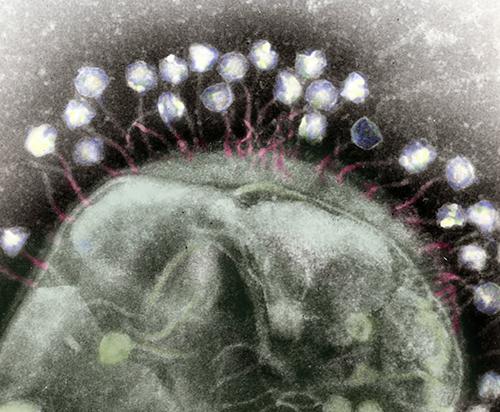Clinical laboratories and microbiologists may soon have new powerful tools for fighting antimicrobial resistant bacteria that saves lives
Superbugs—microbes that have developed multidrug resistance—continue to cause problems for clinical laboratories and hospital antibiotic stewardship programs around the world. Now, scientists at San Diego State University (SDSU) believe that bacteriophages (phages) could provide a solution for dealing with multi-drug resistant superbugs.
Phages are miniscule, tripod-looking viruses that are genetically programmed to locate, attack, and eradicate a specific kind of pathogen. These microscopic creatures have saved lives and are being touted as a potential solution to superbugs, which are strains of bacteria, viruses, parasites, and fungi that are resistant to most antibiotics and other treatments utilized to counteract infections.
“These multi-drug-resistant superbugs can cause chronic infections in individuals for months to years to sometimes decades,” Dwayne Roach, PhD, Assistant Professor of Bacteriophages, Infectious Disease, and Immunology at SDSU told CNN. “It’s ridiculous just how virulent some of these bacteria get over time.”
Labs across the country are conducting research on phages in eradicating superbugs. Roach’s lab is currently probing the body’s immune response to phages and developing purification techniques to prepare phage samples for intravenous use in patients.

“There are a lot of approaches right now that are happening in parallel,” said Dwayne Roach, PhD (above), Assistant Professor of Bacteriophages, Infectious Disease, and Immunology at San Diego State University (SDSU), in a CNN interview. “Do we engineer phages? Do we make a phage cocktail, and then how big is the cocktail? Is it two phages or 12 phages? Should phages be inhaled, applied topically, or injected intravenously? There’s a lot of work underway on exactly how to best do this.” Clinical laboratories that test for bacterial infections may play a key role in diagnosis and treatment involving bacteriophages. (Photo copyright: San Diego State University.)
Building Libraries of Phages
When certain a bacterial species or its genotypes needs to be annihilated, a collection of phages can be created to attack it via methods that enter and weaken the bacterial cell. The bacteria will attempt to counter the intrusion by employing evasive actions, such as shedding outer skins to eliminate the docking ports utilized by the phages. These maneuvers can cause the bacteria to lose their antibiotic resistance, making them vulnerable to destruction.
Some research labs are developing libraries of phages, accumulating strains found in nature in prime breeding grounds for bacteria to locate the correct phage for a particular infection. Other labs, however, are speeding up the process by producing phages in the lab.
“Rather than just sourcing new phages from the environment, we have a bioreactor that in real time creates billions upon billions of phages,” Anthony Maresso, PhD, Associate Professor at Baylor College of Medicine in Houston told CNN. “Most of those phages won’t be active against the drug-resistant bacteria, but at some point, there will be a rare variant that has been trained, so to speak, to attack the resistant bacteria, and we’ll add that to our arsenal. It’s a next-generation approach on phage libraries.”
Maresso and his team published their findings in the journal Clinical Infectious Diseases titled, “A Retrospective, Observational Study of 12 Cases of Expanded-Access Customized Phage Therapy: Production, Characteristics, and Clinical Outcomes.”
For the Baylor study, 12 patients were treated with phages customized to each individual’s unique bacterial profile. The antibiotic-resistant bacteria were exterminated in five of the patients, while several others showed improvement.
Clinical trials are currently being executed to test the effectiveness of phages against a variety of chronic health conditions, including:
- Intractable urinary tract infections
- Chronic constipation
- Joint infections
- Diabetic foot ulcers
- Tonsillitis
- Reoccurring infections in patients with cystic fibrosis
Using a phage cocktail could be used to treat a superbug outbreak in real time, while preventing a patient from a future infection of the same superbug.
“The issue is that when patients have infections with these drug-resistant bacteria, they can still carry that organism in or on their bodies even after treatment,” Maroya Walters, PhD, epidemiologist at the federal Centers for Disease Control and Prevention (CDC) told CNN.
“They don’t show any signs or symptoms of illness, but they can get infections again, and they can also transmit the bacteria to other people,” she added.

More Studies are Needed
According to CDC data, more than 2.8 million antimicrobial-resistant (AMR) infections occur annually in the United States. More than 35,000 people in the country will die as a result of these infections.
In addition, AMR infections are a huge global threat, associated with nearly five million deaths worldwide in 2019. Resistant infections can be extremely difficult and sometimes impossible to treat.
“It’s estimated that by 2050, 10 million people per year—that’s one person every three seconds—is going to be dying from a superbug infection,” epidemiologist Steffanie Strathdee, PhD, Associate Dean of Global Health Services and co-director at the Center for Innovative Phage Applications and Therapeutics (IPATH) at the UC San Diego School of Medicine, told CNN.
The CDC’s 2019 report on bacteria and fungi antimicrobial resistant threats named five pathogens as urgent threats:
- Carbapenem-resistant Acinetobacter
- Candida auris
- Clostridioides difficile
- Carbapenem-resistant Enterobacterales
- Drug-resistant Neisseria gonorrhoeae
More research is needed before phages can be used clinically to treat superbugs. But if phages prove to be useful in fighting antibiotic-resistant bacteria, microbiologists and their clinical laboratories may soon have new tools to help protect patients from these deadly pathogens.
—JP Schlingman
Related Information:
Superbug Crisis Threatens to Kill 10 Million Per Year by 2050. Scientists May Have a Solution
About Antimicrobial Resistance
Why Antibiotics Fail, and How We Can Do Better
Cataloging Nature’s Hidden Arsenal: Viruses That Infect Bacteria


